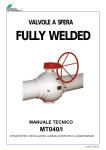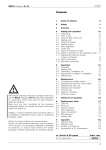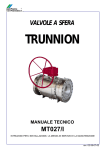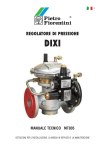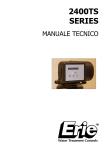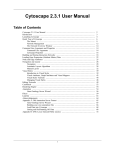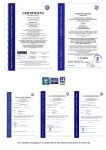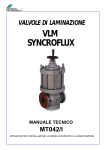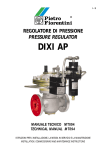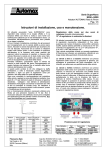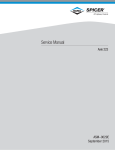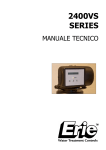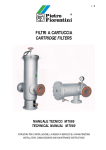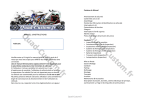Download valvola di controllo control valve deltaflux manuale tecnico mt100
Transcript
I-E VALVOLA DI CONTROLLO CONTROL VALVE DELTAFLUX MANUALE TECNICO MT100 TECHNICAL MANUAL MT100 ISTRUZIONI PER L’INSTALLAZIONE, LA MESSA IN SERVIZIO E LA MANUTENZIONE INSTALLATION, COMMISSIONING AND MAINTENANCE INSTRUCTIONS Edizione Gennaio 2002 Issue January 2002 MANUALE TECNICO MT100 TECHNICAL MANUAL MT100 AVVERTENZE PRECAUTIONS AVVERTENZE GENERALI GENERAL PRECAUTIONS - L’apparecchiatura descritta in questo manuale è un dispositivo soggetto a pressione inserito in sistemi pressurizzati; - l’apparecchiatura in questione è normalmente inserita in sistemi che trasportano gas infiammabili (ad esempio gas naturale). - The apparatus described in this manual is a device subject to pressure installed in systems under pressure; - the apparatus in question is normally installed in systems for transporting flammable gases (natural gas, for example). AVVERTENZE PER GLI OPERATORI PRECAUTIONS FOR THE OPERATORS Prima di procedere all’installazione, messa in servizio o manutenzione gli operatori devono: - prendere visione delle disposizioni di sicurezza applicabili all’installazione i n cui devono operare; - ottenere le necessarie autorizzazioni ad operare quando richieste; - dotarsi delle necessarie protezioni individuali (casco, occhiali, ecc.); - assicurarsi che l’area in cui si deve operare sia dota ta delle protezioni collettive previste e delle necessarie indicazioni di sicurezza. Before proceeding with installation, commissioning or maintenance, operators must: - examine the safety provisions applicable to the installation in which they must work; - obtain the authorisations necessary for working when so required; - use the necessary means of individual protection (helmet, goggles, etc.); - ensure that the area in which they operate is fitted with the means of collective protection envisaged and with the necessary safety indications. MOVIMENTAZIONE HANDLING La movimentazione dell’apparecchiatura e dei suoi componenti deve essere eseguita dopo aver valutato che i mezzi di sollevamento siano adeguati ai carichi da sollevare (capacità di sollevamento e funzionalità). La movimentazione dell’apparecchiatura deve essere eseguita utilizzando i punti di sollevamento previsti sull’apparecchiatura stessa. L’impiego di mezzi motorizzati è riservato al personale a ciò preposto. The handling of the apparatus and of its components must only be carried out after ensuring that the lifting gear is adequate for the loads to lift (lifting capacity and functionality). The apparatus must be handled using the lifting points provided on the apparatus itself. Motorised means must only be used by the persons in charge of them. INSTALLAZIONE INSTALLATION Qualora l’installazione dell’apparecchiatura richieda l’applicazione in campo di raccordi a compressione, questi devono essere installati seguendo le istruzioni del produttore dei raccordi stessi. La scelta del raccordo deve essere compatibile con l’impiego specificato per l’apparecchiatura e con le specifiche di impianto quando previste. If the installation of the apparatus requires the application of compression fittings in the field, these must be installed following the instructions of the manufacturer of the fittings themselves. The choice of the fitting must be compatible with the use specified for the apparatus and with the specifications of the system when envisaged. MESSA IN SERVIZIO COMMISSIONING La messa in servizio deve essere eseguita da personale adeguatamente preparato. Durante le attività di messa in servizio il personale non strettamente necessario deve essere allontanato e deve essere adeguatamente segnalata l’area di interdizione (cartelli, transenne, ecc.). Verificare che le caratteristiche dell’apparecchiatura siano quelle richieste. Durante la messa in servizio devono essere valutati i rischi determinati da eventuali scarichi in atmosfera di gas infiammabili o nocivi. Per installazione su reti di distribuzione per gas naturale occorre considerare il rischio di formazioni di miscela esplosiva (gas/aria) all’interno delle tubazioni. Commissioning must be carried out by adequately trained personnel. During the commissioning activities, the personnel not strictly necessary must be ordered away and the no-go area must be properly signalled (signs, barriers, etc.). Check that the features of the apparatus are those requested. When commissioning, the risks associated with any discharges into the atmosphere of flammable or noxious gases must be assessed. In installations in natural gas distribution networks, the risk of the formation of explosive mixtures (gas/air) inside the piping must be considered. 2 MANUALE TECNICO MT100 TECHNICAL MANUAL MT100 INDICE INDEX CARATTERISTICHE PAGINA 4 MAIN FEATURES PAGE 4 1 INSTALLAZIONE DELLA VALVOLA 9 1 VALVE INSTALLATION 9 2 SOSTITUZIONE DELL’ANELLO DI GRAFITE 9 2 SUBSTITUTION OF THE FIRE-SAFE RING 9 2.1 SOSTITUZIONE DELL’ANELLO DI GRAFITE 9 2.1 SUBSTITUTION OF THE FIRE-SAFE RING 9 2.2 SOSTITUZIONE DELL’ANELLO DI GRAFITE 10 2.2 SUBSTITUTION OF THE FIRE-SAFE RING 10 2.3 SOSTITUZIONE DELL’ANELLO DI GRAFITE 10 2.3 SUBSTITUTION OF THE FIRE-SAFE RING 10 2.4 SOSTITUZIONE DELL’O-RING 11 2.4 SUBSTITUTION OF THE O-RING 11 3 SOSTITUZIONE DELLA SEDE E GUARNIZIONE 11 3 SUBSTITUTION OF THE SEAT AND GASKET 11 4 SOSTITUZIONE DELL’O-RING SULLO STELO 12 4 SUBSTITUTION OF THE STEAM O-RING 12 5 LUBRIFICAZIONE 13 5 GENERAL LUBRIFICATION 13 6 LISTA DEI RICAMBI CONSIGLIATI 14 6 RECOMMENDED SPARES 14 3 MANUALE TECNICO MT100 TECHNICAL MANUAL MT100 CARATTERISTICHE GENERAL La Pietro Fiorentini mette a disposizione del cliente una gamma completa di valvole di regolazione in grado di fornire la soluzione ottimale per qualsiasi problema od applicazione. La necessità di trasportare rilevanti portate con minime cadute di pressione localizzate sulla valvola di regolazione, richiede la combinazione di ampia capacità ed elevata rangeability. Questa combinazione è tipica della configurazione di una valvola a sfera. La valvola a sfera offre il più elevato rapporto Cv/diametro. Questo si traduce in minori dimensioni d’ingombro della valvola e dell’impianto, configurazioni più semplici del piping, facilità di installazione e manutenzione. Le speciali configurazioni dei trim della valvola DELTAFLUX consentono un’elevata rangeability, un’eccellente tenuta, l’abbattimento del rumore e una riduzione del fenomeno di cavitazione. Pietro Fiorentini provides complete control ball valve units to solve any customer problems and applications. STELO ANTIESPULSIONE BLOW OUT PROOF STEM Lo stelo si può montare solo dalla parte interna della valvola. Un robusto collare lo trattiene all’interno del corpo. Questa soluzione permette di sostituire la guarnizione esterna sullo stelo qualora venga danneggiata. The stem can be assembled only from the nternal side of the valve. A stout collar eeps it inside the body. This solution llows to replace the outside gasket on he stern in case it is damaged. The need to transfer large volumetric flows with minimal pressure drop located over the control valve calls for a combination of high capacity and rangeability. This combination is inherent in ball valve design. Quarter-turn ball valve constructions have the highest possible Cv/size ratio. This means smaller external valve dimensions, compact valve solutions, simple pipe configurations, light and easy installation. The special trims design of DELTAFLUX provides high rangeability, excellent tightness and source treatment for noise and cavitation. METAL TO METAL SEAT TENUTA METALLO SU METALLO PROGETTAZIONE DEL TRIM PER IL FLUIDO DA REGOLARE SPECIFIC TRIM APPLICATIONS ADATTO SUITABLE FOR APPLICATIONS ADATTA PER APPLICAZIONI CON GAS E LIQUIDI FOR GAS DIFFERENT AND LIQUID REPLACEABLE TRIM TRIM SOSTITUIBILE NON CLOGGING, SELF CLEANING AND FLUSHING POCO SOGGETTA AD INTASAMENTI, POCO SENSIBILE ALLO SPORCO E AI FLUIDI CARICHI 4 MANUALE TECNICO MT100 TECHNICAL MANUAL MT100 AMPIA VARIABILITÀ DI ATTUATORI APPLICABILI WIDE RANGE OF ACTUATOR TYPE AMPIA VARIABILITÀ DI CONTROLLORI UTILIZZABILI WIDE RANGE OF CONTROLLERS TYPE ELIMINAZIONE DELLA CAVITAZIONE CAVITATION AND VIBRATION FREE SFERA IMPERNIATA TRUNNION MOUNTED BALL OTTIMA TENUTA CON VALVOLA CHIUSA GOOD TIGHTNESS WITH VALVE CLOSED BASSE PERDITE DI CARICO LOW PRESSURE DROP ALTA AFFIDABILITÀ HIGH RELIABILITY COSTRUZIONE CONFORME ALLE NORME ASTM - ASME - NACE - API -ANSI CONSTRUCTION ACCORDING TO STANDARD ASTM ASME - NACE - API -ANSI CLASSE: 150 - 300 - 400 - 600 -900 DIAMETRI NOMINALI: 2'' A 24" PRESSURE CLASSES: 150 - 300 - 400 600 - 900 VALVE SIZE: DN 2'' TO 24" PASSAGGIO TOTALE O RIDOTTO FULL BORE AND REDUCED BORE TIPO DI ESTREMITÀ: RAISED FACES OR RING JOINT OR WELDING ENDS ENDS: RAISED FACES OR RING JOINT OR WELDING ENDS 5 MANUALE TECNICO MT100 TECHNICAL MANUAL MT100 DIREZIONE DEL FLUSSO FLOW DIRECTION 6 MANUALE TECNICO MT100 TECHNICAL MANUAL MT100 7 MANUALE TECNICO MT100 CORPO SEDE SFERA STELO COPERCHIO SUPERIORE O-RING TIRANTE FILETTATO DADO CUSCINETTO REGGISPINTA VITE COPERCHIO INFERIORE TAPPO VITE O-RING VITE MOLLA O-RING CUSCINETTO CUSCINETTO O-RING IMBOCCO MONTE IMBOCCO VALLE VITE CUSCINETTO STELO FLANGIA COMANDO O-RING SPINA O-RING (O ANELLO DI GRAFITE POS. 58) ANELLO DI CENTRAGGIO INGRASSATORE ANELLO SFERA VITE O-RING TARGHETTA INDICE FLUSSO GUARNIZIONE METALLO CALOTTA SFERICA ANELLO ELASTICO PORTA ANELLI MONTE PORTA ANELLI VALLE TECHNICAL MANUAL MT100 1 2 3 4 5 6 7 8 9 10 12 14 15 17 18 20 21 22 23 24 26 26 28 31 34 38 44 45 50 62 174 175 177 244 252 294 295 296 298 8 BODY SEAT BALL STEM BONNET UP O-RING STUD BOLT NUT THRUST BEARING CAP SCREW BONNET LOW PLUG CAP SCREW O-RING CAP SCREW SPRING O-RING THRUST BEARING THRUST BEARING O-RING INLET TAIL PIECE OUTLET TAIL PIECE CAP SCREW THRUST BEARING ACTUATOR FLANGE O-RING PIN O-RING (OR GRAPHITE RING POS. 58) CENTERING RING GREASE NIPPLE RETAINING RING CAP SCREW O-RING DIRECTION FLOW PLATE METAL GASKET CALOTTE ELASTIC RING INLET HOLDER RING OUTLET HOLDER RING MANUALE TECNICO MT100 TECHNICAL MANUAL MT100 1. INSTALLAZIONE DELLA VALVOLA 1 VALVE INSTALLATION 1.1 Rimuovere le protezioni dagli imbocchi. 1.2 Ispezionare l’interno della valvola, verificare che sia pulito e senza corpi estranei; la valvola viene spedita con le estremità chiuse da protezioni, tuttavia durante li trasporto materiali estranei possono essere introdotti nel foro di passaggio. La presenza di corpi estranei tra la sede e la sfera può danneggiare la superficie di tenuta. 1.3 Aprire e chiudere la valvola per verificare che funzioni correttamente. 1.4 Prima di installare la valvola sulla tubazione pulire accuratamente l’interno della tubazione stessa. 1.5 Installare la valvola sulla tubazione rispettando l’indicazione della direzione di flusso LA VALVOLA NON È BIDIREZIONALE. 1.1 Remove on the end connection the protection caps. 1.2 Inspect the valve bore for foreign parts and clean if necessary. Valve are shipped with ends sealed, but during the transit some foreign material may be introduced into the valve bore. The presence of foreign parts between the seat and the ball could damage the seat thigtness facing. 1.3 Open and close the valve completely in order to check the right operability. 1.4 Before installation of the valve on the pipeline provide for cleaning it. 1.5 Install the valve on the line; respecting the valve flow direction. THE VALVE IS NOT BI-DIRECTIONAL. 2 SOSTITUZIONE DELL’ ANELLO DI GRAFITE (58) OPPURE DELL’O-RING (56) 2 SUBSTITUTION OF THE GRAPHITE RING (58) OR THE O-RING (56) Le operazioni sottoscritte possono essere effettuate senza rimuovere la valvola dalla linea. Verificare che la valvola sia completamente chiusa (o aperta). Scaricare la pressione dalla linea lasciando aperto il tappo (14). This maintenance operation can be performed without removing the valve from the line. Check that the valve are in fully closed (or open) position. Bleed off line pressure leaving plug (14) open. 2.1 SOSTITUZIONE DELL’ ANELLO DI GRAFITE (58) PER DN 2" - 4" CLASSE 150 - 300 E DN 2" - 3" CLASSE 600 CON LEVA 2.1 SUBSTITUTION THE GRAPHITE RING (58) FOR ND 2" - 4" CLASS 150 - 300 AND ND 2" - 3" CLASS 600 WITH LEVER 2.1.1 Svitare il dado (52), togliere la rosetta (75), il mozzo leva (74), il dado (48), la molla a tazza (49), il fermo stelo (66), la seconda molla a tazza (49), l’anello di centraggio (50) l’anello di grafite (45). 2.1.2 Pulire e lubrificare la sede dell’anello di grafite, assemblare la nuovo anello di grafite (45) e l’anello di centraggio (50). 2.1.3 Assemblare la molla a tazza (49), il fermo stelo (66), la seconda molla a tazza (49),il dado (48), il mozzo leva (74), la rosetta (75), il dado (52) e fissarlo. 2.1.1 Loosen the nut (52), remove the washer (75), the wrench head (74), the nut (48), the spring washer (49), the stem stop (66), the second spring washer (49), the centering ring (50) and the graphite ring (45). 2.1.2 Clean and lubricate the graphite ring groove, assemble the new graphite ring (45) and the centering ring (50). 2.1.3 Assembly the spring washer (49), the stem stop (66), the second spring washer (49), the nut (48), the wrench head (74), the washer (75), the nut (52) and retaining it. 9 MANUALE TECNICO MT100 TECHNICAL MANUAL MT100 2.2 SOSTITUZIONE DELL’ ANELLO DI GRAFITE (58) PER DN 6" CLASSE 150 300 CON LEVA 2.2 SUBSTITUTION THE OR GRAPHITE RING (58) FOR DN 6" CLASS 150 - 300 WITH LEVER 2.2.1 Rimuovere la spina elastica (19) e il mozzo leva (74); svitare il dado (48), togliere la molla a tazza (49), il fermo stelo (66) e la seconda molla a tazza (49). 2.2.2 Togliere l’anello di centraggio (50) e l’anello di grafite (58). 2.2.3 Pulire e lubrificare la sede dell’anello di grafite, assemblare la nuovo anello di grafite (58) il l’anello di centraggio (50), la molla a tazza (49), il fermo stelo (66), la seconda molla a tazza (49), il dado (48), il mozzo leva (74) e la spina elastica (19). 2.2.1 Remove the elastic pin (19) and the wrench head (74); unscrew the nut (48), remove the spring washer (49), the stem stop (66) and the second spring washer (49). 2.2.2 Remove the centering ring (50) and the graphite ring (58). 2.2.3 Clean and lubricate the graphite ring groove, assembly the new graphite ring (58) the centering ring (50), the spring washer (49), the stem stop (66), the second spring washer (49), the nut (48), the wrench head (74) and the elastic pin (19). 2.3 SOSTITUZIONE DELL’ ANELLO DI GRAFITE (58) PER DN 2" - 6" CLASSE 150 - 300 E DN 2" - 3" CLASSE 600 CON COMANDO MANUALE 2.3 SUBSTITUTION THE GRAPHITE (58) FOR DN 2" - 6" CLASS 150 - 300 AND DN 2" - 3" CLASS 600 WITH GEAR OPERATOR 2.3.1 Svitare le viti (10) e togliere il comando. 2.3.1 Unscrew the screws (10) and remove the gear operator. 2.3.2 Unscrew the screws (15) remove the flange (34), the centering ring (50) and the graphite ring (58). 2.3.3 Clean and lubricate the graphite ring groove. Assembly the new graphite ring (58), assembly the centering ring (50), the flange (34) and retightening the screws (15). 2.3.4 Assembly the gear operator and re-tightening the screws (10). 2.3.2 Svitare le viti (15) togliere la flangia (34), l’anello di centraggio (50) e l’anello di grafite (58). 2.3.3 Pulire e lubrificare la sede dell’anello di grafite, assemblare la nuovo anello di grafite (58) il l’anello di centraggio (50), la flangia (34) e serrare le viti (15). 2.3.4 Riposizionare il comando e serrare le viti (10). * Si suggerisce di contrassegnare la posizione del comando prima della rimozione e di riassemblarlo nella stessa posizione. Nel caso di attuatore ricordare di regolare i fermi. Eventualmente vedere la documentazione dell’attuatore. * Is suggested to sign the position of the gear operator before remove it and reassemble it on the same position. In case of actuator remember too regulate the limits stops. Eventually see the actuator documentation. 10 MANUALE TECNICO MT100 TECHNICAL MANUAL MT100 2.4 SOSTITUZIONE DELL’O-RING (56) O DELL’ ANELLO DI GRAFITE (58) PER DN 8" - 14" CLASSE 150 - 300 E 4" - 12" CLASSE 600 CON COMANDO MANUALE 2.4 SUBSTITUTION THE O-RING (56) OR GRAPHITE (58) FOR DN 8" - 14" CLASS 150 - 300 AND DN 4" - 12" CLASS 600 WITH GEAR OPERATOR 2.4.1 Svitare le viti (35) e togliere il comando con la flangia (34). 2.4.2 Togliere la linguetta (11), l’anello di centraggio (50) e l'O-Ring (56) (o il anello di grafite (58). 2.4.3 Pulire e lubrificare la sede dell’O-Ring (56). Sostituire l’O-Ring (56) (o il anello di grafite (58), e assemblare l’anello di centraggio (50). 2.4.4 Posizionare la flangia (34) con il comando e serrare le viti (35). 2.4.1 Unscrew the screws (35) and remove the gear operator with the flange (34). 2.4.2 Remove the stem key (11), the centering ring (50) and the O-Ring (56) (or graphite ring (58)). 2.4.3 Clean and lubricate the O-Ring groove. Assembly the new O-Ring (56) (or graphite ring (58)), assembly the centering ring (50). 2.4.4 Assembly the flange (34) with the gear operator and retightening the screws (35). * Si suggerisce di contrassegnare la posizione del comando prima della rimozione e di riassemblarlo nella stessa posizione. Nel caso di attuatore ricordare di regolare i fermi. Eventualmente vedere la documentazione dell’attuatore. * Is suggested to sign the position of the gear operator before remove it and reassemble it on the same position. In case of actuator remember too regulate the limits stops. Eventually see the actuator documentation. 3 SOSTITUZIONE DELLA SEDE (2) E DELLA GUARNIZIONE (252) 3 SUBSTITUTION OF SEAT (2) AND GASKET (252) 3.1.1 Portare la valvola in posizione di chiusura e scaricare la pressione dalla tubazione. 3.1.1 Turn the valve to fully closed position and bleed off the pressure of the line (upstream and downstream). 3.1.2 Take off the valve from the line and place it over with inlet tail piece (26) on the top. 3.1.2 Rimuovere la valvola dalla tubazione e posizionarla sul banco di lavoro con l’imbocco di monte (26) rivolto verso l’alto. 3.1.3 Rimuovere i dadi (8). 3.1.4 Rimuovere l’imbocco (26); è possibile ora rimuovere la sede (2) con le molle (20) e l'ORing (6); pulire e lubrificare la sede del seggio nell’imbocco. 3.1.5 Pulire e lubrificare la nuova sede (20) e la sede dell’O-Ring. Montare il nuovo O-Ring (6). 3.1.6 Rimuovere le viti (175), l’anello sfera (174), l’ORing (177) e la guarnizione (252); pulire e lubrificare la sede dell’O-Ring. Montare il nuovo O-Ring (177), la nuova guarnizione (252) sulla sfera, l’anello sfera (174) e le viti (175). 3.1.7 Per facilitare l’inserimento della nuova sede (2) con gli O-Ring (17) operare come di seguito descritto: - montare le molle (20) con del grasso nelle relative sedi; - posizionare la sede (2) sull’imbocco (26); - inserire l’imbocco (26) sui tiranti (7) in modo che l’imbocco stesso si inserisca sul corpo (1). 3.1.3 Loosen the nuts (8). 3.1.4 Remove the tail piece (26), now is possible remove the seat (2) with the springs (20), the ORing (6); clean and lubricate the seat poket. 3.1.5 Clean and lubricate the new seat (20) and the O-Ring groove. Assembly the new O-Ring (6). 3.1.6 Remove cap screw (175), the retaining ring (174), the O-Ring (177) and the gasket (252); clean and lubricate the O-Ring groove. Install new O-Ring (177), new gasket (252) on the ball, the retaining ring (174) and the cap screw (175). 3.1.7 In order to make easier insertion of new seat (2) with the O-Rings (17) do as follows: - assemble the springs (20) with the grease into the relevant sid;, - insert the seat (2) in to the tailpiece (26); - Insert the tail piece (26) into the stud bolts (7) in such way that the tail piece enters in the body (1). 3.1.8 At the same time gradually tighten the nuts (8). 3.1.8 Stringere gradualmente e uniformemente i dadi (8). * La pulitura può essere eseguita con un panno morbido im bevuti di soluzione di petrolio * Cleaning can be carryout with a soft cloth in an oil solution. 11 MANUALE TECNICO MT100 TECHNICAL MANUAL MT100 4 SOSTITUZIONE DELL’O-RING (21) SULLO STELO, I REGGISPINTA (9) E (31) E I CUSCINETTI (22) (23) 4 SUBSTITUTION OF O-RING (21) ON THE STEM, THRUST PLATE (9) (31) AND BEARING (22) (23) 4.1.1 Eseguire le azioni indicate al punto 3.1.1; ai punti 2.1.1 o 2.2.1,2.2.2 o 2.3.1,2.3.2 oppure 2.4.1, 2.4.2 in base alle versioni da revisionare. 4.1.2 Togliere le viti (18) e rimuovere il coperchio (5). 4.1.9 Montare il coperchio superiore (5) sul corpo e fissare le viti (18). 4.1.10 Allentare le viti (28), rimuovere il coperchio inferiore (12), l’O-Ring (24), il cuscinetto inferiore (23) e il reggispinta (9). 4.1.11 Pulire e lubrificare la sede dell’O-Ring, montare il nuovo O-Ring, il cuscinetto inferiore(23), il reggispinta (9) e lubrificare con grasso. 4.1.12 Montare il coperchio inferiore (12) nel corpo e fissare le viti (28). 4.1.13 Eseguire le azioni indicate ai punti 2.1.3 o 2.2.3 o 2.3.3 oppure 2.4.3. 4.1.14 Controllare la tenuta della sede e azionare la valvola per verificarne il corretto funzionamento. 4.1.1 Carry out the same steps as indicate at point 3.1.1, at point 2.2.1, 2.2.2 or 2.3.1, 2.3.2 or 2.4.1, 2.4.2 4.1.2 Loosen the screws (18)and remove the upper bonnet (5). 4.1.3 Remove the stem (4) from internal side of bonnet. 4.1.4 Remove the O-Rings (21) (38), clean and lubricate with light oil, assemble the new O-Ring (21) (38) 4.1.5 Substitute the thrust bearing (9) (31) and the upper bearing (22). 4.1.6 Assembly the upper bearing (22) into the bonnet (5), the thrust bearing (31) onto the stem (4) and the thrust bearing (9) on to hub of ball. 4.1.7 After smearing with a thin layer of light oil assembly the stem (4) from internal side of bonnet. 4.1.8 Place the stem (4) with the connecting planes to ball enters into relative planes of hub ball or in the thrust bushing (32) of the ball. 4.1.9 Assemble the bonnet (5) into the body and fix the screws (18). 4.1.10 Loosen the screw (28), remove the lower bonnet (12), the O-Ring (24) and the lower bearing (23) and thrust bearing (9). 4.1.11 Clean and lubricate th e O-Ring groove, assembly the new O-Ring, the new bearing the thrust bearing (9); lubricate with light oil. 4.1.12 Assemble the lower bonnet (12) into body and fix the screws (28). 4.1.13 Carry out the same steps as indicated on point 2.1.3 or 2.2.3 or 2.3.3 or 2.4.3 4.1.14 Check the seal tightness and operate the valve in order to verify the right functionally. 5 LUBRIFICAZIONE 5 GENERAL RUBRICATE Per lubrificare tutte le parti della valvola è consigliato l’uso di TECNOLUBE SEAL POLYMER 1000 oppure lubrificanti con prestazioni similari. For lubricate all the components of the valve during the assembly is suggested the use of TECNOLUBE SEAL POLYMER 1000 or similarequivalent see relative data sheet. 4.1.3 Togliere lo stelo (4) dalla parte interna del coperchio superiore. 4.1.4 Rimuovere gli O-Ring (21) (38), pulire e lubrificare la sede e assemblare i nuovi O-Ring (21) (38). 4.1.5 Sostituire il reggispinta (9) (31) e il cuscinetto superiore (22). 4.1.6 Montare il cuscinetto superiore (22) sul coperchio (5), il reggispinta (31) sullo stelo (4), ed il reggispinta (9) sul mozzo della sfera. 4.1.7 Dopo aver lubrificato con un leggero velo di grasso, infilare lo stelo (4) dalla parte interna del coperchio. 4.1.8 Posizionare lo stelo (4) con le facce parallele accoppiate alle bussole (32) della sfera. 12 MANUALE TECNICO MT100 6 TECHNICAL MANUAL MT100 LISTA DEI RICAMBI CONSIGLIATI 6 RECOMMENDED SPARES - FIG. 230 PASSAGGIO TOTALE CLASSE 150 – 300 - 600 - FIG. 230 FULL BORE CLASS 150 – 300 - 600 - FIG. 260 PASSAGGIO RIDOTTO CLASSE 150 – 300 - 600 - FIG. 260 REDUCE BORE CLASS 150 – 300 - 600 13 MANUALE TECNICO MT100 POS. ITEM 2 6 9 17 21 22 23 24 31 38 56 177 252 TECHNICAL MANUAL MT100 DESCRIZIONE DESCRIPTION Sede Seat O-Ring Cuscinetto reggispinta Thrust bearing O-Ring O-Ring Cuscinetto superiore Upper bearing Cuscinetto inferiore Lower bearing O-Ring Cuscinetto reggispinta Thrust bearing O-Ring O-Ring O-Ring Guarnizione Gasket 14 N. PEZZI PIECES NR. 1 2 2 1 2 1 1 1 1 1 1 1 MANUALE TECNICO MT100 TECHNICAL MANUAL MT100 PER L’ORDINAZIONE DEI RICAMBI PRECISARE WHENORDERINGSPAREPARTS,PLEASESPECIFY Tipo di valvola Type of valve Dn (diametro nominale ) Dn (nominal diameter) Classe (150-300-400-600-900-1500) Class (150-300-400-600-900-1500) N. di Fabbrica (Matricola) Serial no. (Serial no.) Anno di costruzione Year of manufacture Tipo di fluido impiegato Type of fluid used Il n. del particolare (posizione) The no. of the part (position no.) Quantità desiderata Quantity desired NOTE NOTES 15 MANUALE TECNICO MT100 TECHNICAL MANUAL MT100 I dati sono indicativi e non impegnativi. Ci riserviamo di apportare eventuali modifiche senza preavviso. The data are not binding. We reserve the right to make modifications without prior notice. Pietro Fiorentini S.p.A. UFFICI COMMERCIALI: OFFICES: I-20124 MILANO Italy - Via Rosellini, 1 - Phone +39.02.6961421 (10 linee a.r.) - Telefax +39.02.6880457 E-mail: [email protected] I-36057 ARCUGNANO (VI) Italy - Via E. Fermi, 8/10 - Phone +39.0444.968511 (10 linee a.r.) - Telefax +39.0444.960468 E-mail: [email protected] I-80142 NAPOLI Italy - Via B. Brin, 69 - Phone +39.081.5544308 - +39.081.5537201 - Telefax +39.081.5544568 E-mail: [email protected] ASSISTENZA POST-VENDITA E SERVIZIO RICAMBI: SPARE PARTS AND AFTER-SALES SERVICE: I-36057 ARCUGNANO (VI) - Italy - Via E. Fermi, 8/10 - Phone +39.0444.968511 (10 linee a.r.) - Telefax +39.0444.968513 - E-mail: [email protected] 16

















